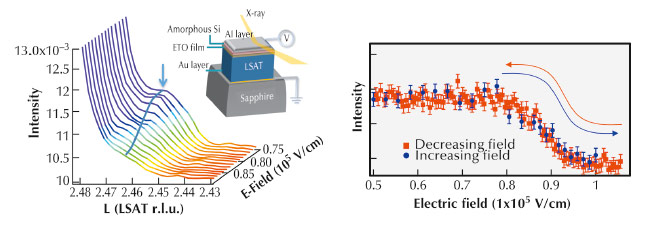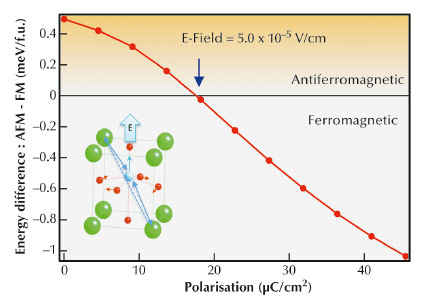- Home
- Users & Science
- Scientific Documentation
- ESRF Highlights
- ESRF Highlights 2013
- Electronic structure and magnetism
- Magnetoelectronics: harnessing the coupling between magnetic and electric parameters
Magnetoelectronics: harnessing the coupling between magnetic and electric parameters
Although scientists have been aware that magnetism and electricity are two sides of the same proverbial coin for almost 150 years, researchers are still trying to find new ways to use a material‘s electric behaviour to influence its own magnetic behaviour, or vice versa.
Our research has led to the discovery of a simple mechanism for controlling magnetic order in a particular class of materials known as “magnetoelectrics”. The name derives from the fact that the magnetic and electric properties are coupled to each other. Because this physical link potentially allows for significantly increased efficiencies in both memory and logic devices, scientists have taken a special interest in these materials.
We focused on the compound EuTiO3 (europium-titanium oxide), which is a simple perovskite system with a known magneto-dielectric coupling phenomenon making it especially well suited to this experiment [1]. The titanium atom sits in the middle of a cage constructed of the europium and oxygen atoms. By first compressing the cage through the growth of a thin film of EuTiO3 on a similar crystal with a smaller lattice and then applying a voltage, the titanium shifts slightly, electrically polarising the system, and more importantly, changing the effective magnetic order of the material [2].
Underlying this behaviour is the interesting fact that EuTiO3 intrinsically has both coexisting ferromagnetic and antiferromagnetic interactions [3]. Typically the latter is much stronger and dominates the material, however through the tailored distortion induced in the strained film, the relative magnetic energies are brought closer and thus the spin order becomes less stable and more susceptible to external influence. In this case, an electric field induces an electric polarity within the typically paraelectric system.
The titanium atom determines the electric character while the europium atom contributes the magnetic element, however the titanium also plays an important role in the mediation of the europium spin ordering. It allows the europium spins to communicate, the strength of this interaction is dependent upon how well aligned the Eu and Ti atoms are. The interactions are strongest when they form a straight line, however if either atom deviates from this line, then the interaction between the Eu spins falls off. On the other hand, the ferromagnetic interactions do not depend upon the Ti atom and so are not affected. The precariously balanced spin state shifts with Ti displacement under applied field suppressing the AFM order until eventually the FM exchange interactions begin to locally determine the spin order.
 |
|
Fig. 111: Left panel: A series of reciprocal scans through the decreasing antiferromagnetic signature reflection with incrementally increasing electric field. Inset: A depiction of the in situ sample environment used in the experiment. Right panel: Presents a plot of the magnetic reflected intensity with both increasing and decreasing electric field. |
Employing a combination of experimental measurements including X-ray magnetic scattering with advanced density functional theory calculations, we could both monitor the extinction of the magnetic order and predict roughly with what electric field strength this phenomenon would occur (Figure 111 and Figure 112). This feat illustrates the strength of using both approaches to understand the intricate mechanisms driving such physical properties.
 |
|
Fig. 112: Density functional theory calculated energy differences between the AFM and FM state with increasing titanium displacement from the central position. With an equivalent calculated electric field of 1e10–5 V/cm, both the AFM and FM order become degenerate. Inset: Illustrates the simple Ti displacement, distorting the Eu-Ti-Eu alignment leading to AFM suppression. |
A particularly interesting aspect of this finding is the concept that multiferoicity or specifically a feroelectric-ferromagnet is not necessary to generate a giant ME effect. Rather, a far more common paraelectric antiferromagnet insulator has presented exactly this effect with a simple but powerful underlying mechanism.
This new approach to cross-coupling magnetoelectricity could prove a key step towards the development of next-generation memory storage, improved magnetic field sensors, and many other long dreamed of applications. Potential magnetic and electric memories each have a distinct appeal to researchers. Electric memories – such as the kind used into today’s electronics – allow computers to write data fast and very efficiently. Magnetic memories are less energy efficient, but are extraordinarily robust. Because the electric and magnetic parameters in these particular materials are so strongly linked, engineers might also be able to use them in the future to create non-binary memories.
Principal publication and authors
P.J. Ryan (a), J.-W. Kim (a), T. Birol (b), P. Thompson (c,d), J.-H. Lee (a), X. Ke (e), P.S. Normile (f), E. Karapetrova (a), P. Schiffer (g), S.D. Brown (c,d), C.J. Fennie (b) and D.G. Schlom (h), Nature Communications 4, 1334 (2013).
(a) X-ray Science Division, Argonne National Laboratory, Illinois (USA)
(b) School of Applied Engineering Physics, Cornell University, New York (USA)
(c) Department of Physics, University of Liverpool (UK)
(d) XMaS, the UK-CRG, ESRF
(e) Quantum Condensed Matter Division, Oak Ridge National Laboratory, Tennessee (USA)
(f) Instituto Regional de Investigación Científica Aplicada (IRICA) and Departamento de Física Aplicada, Universidad de Castilla-La Mancha, Ciudad Real (Spain)
(g) Department of Physics and Materials Research Institute, Pennsylvania State University (USA)
(h) Department of Materials Science and Engineering, Cornell University, New York (USA)
References
[1] T. Katsufuji and H. Takagi, Phys. Rev. B 64, 054415–054419, (2001).
[2] J. H. Lee et al., Nature 466, 954 (2010).
[3] H. Akamatsu et al., Phys. Rev B 83, 214421 (2011).



